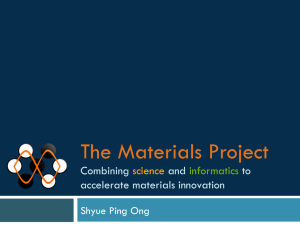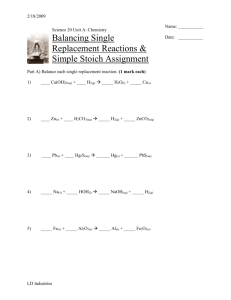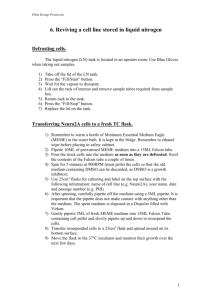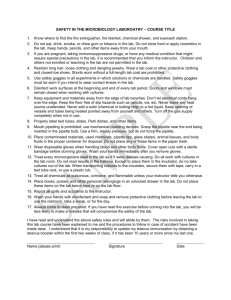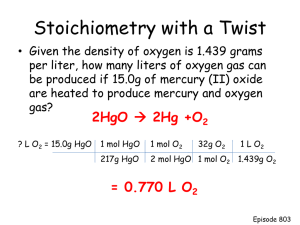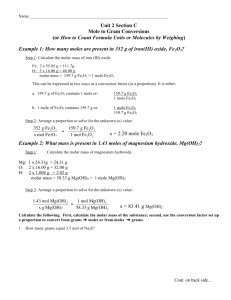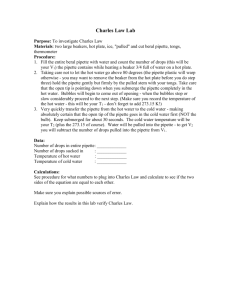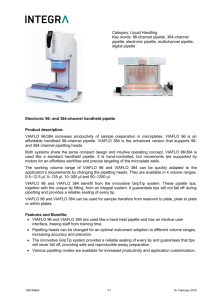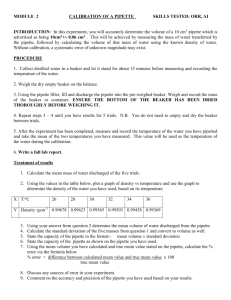Microscale Gas Chemistry, Part 17
advertisement
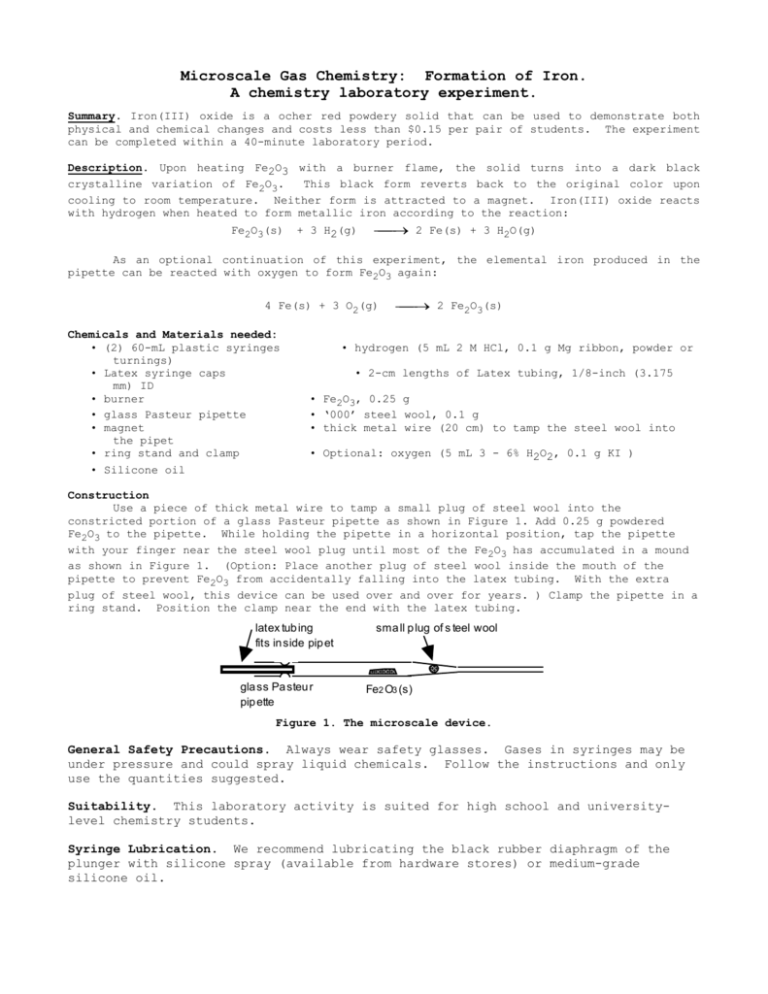
Microscale Gas Chemistry: Formation of Iron. A chemistry laboratory experiment. Summary. Iron(III) oxide is a ocher red powdery solid that can be used to demonstrate both physical and chemical changes and costs less than $0.15 per pair of students. The experiment can be completed within a 40-minute laboratory period. Description. Upon heating Fe2O3 with a burner flame, the solid turns into a dark black crystalline variation of Fe2O3. This black form reverts back to the original color upon cooling to room temperature. Neither form is attracted to a magnet. Iron(III) oxide reacts with hydrogen when heated to form metallic iron according to the reaction: Fe2O3(s) + 3 H2(g) 2 Fe(s) + 3 H2O(g) As an optional continuation of this experiment, the elemental iron produced in the pipette can be reacted with oxygen to form Fe2O3 again: 4 Fe(s) + 3 O2(g) Chemicals and Materials needed: • (2) 60-mL plastic syringes turnings) • Latex syringe caps mm) ID • burner • glass Pasteur pipette • magnet the pipet • ring stand and clamp • Silicone oil 2 Fe2O3(s) • hydrogen (5 mL 2 M HCl, 0.1 g Mg ribbon, powder or • 2-cm lengths of Latex tubing, 1/8-inch (3.175 • Fe2O3, 0.25 g • ‘000’ steel wool, 0.1 g • thick metal wire (20 cm) to tamp the steel wool into • Optional: oxygen (5 mL 3 - 6% H2O2, 0.1 g KI ) Construction Use a piece of thick metal wire to tamp a small plug of steel wool into the constricted portion of a glass Pasteur pipette as shown in Figure 1. Add 0.25 g powdered Fe2O3 to the pipette. While holding the pipette in a horizontal position, tap the pipette with your finger near the steel wool plug until most of the Fe2O3 has accumulated in a mound as shown in Figure 1. (Option: Place another plug of steel wool inside the mouth of the pipette to prevent Fe2O3 from accidentally falling into the latex tubing. With the extra plug of steel wool, this device can be used over and over for years. ) Clamp the pipette in a ring stand. Position the clamp near the end with the latex tubing. latex tub ing fits in side pip et gla ss Pa steu r pip ette sma ll p lug of s teel wool Fe2 O3 (s) Figure 1. The microscale device. General Safety Precautions. Always wear safety glasses. Gases in syringes may be under pressure and could spray liquid chemicals. Follow the instructions and only use the quantities suggested. Suitability. This laboratory activity is suited for high school and universitylevel chemistry students. Syringe Lubrication. We recommend lubricating the black rubber diaphragm of the plunger with silicone spray (available from hardware stores) or medium-grade silicone oil. Preparation of Hydrogen: Prepare a syringeful of hydrogen from 0.1 g Mg (powder, ribbon or turnings) and 3 – 5 mL 2 M HCl(g). Detailed instructions can be found at our website or in our two microscale gas books. Instructions: Part 1. Hold a magnet above the mound of Fe2O3. The compound is not magnetic so nothing should happen. Heat the mound of Fe2O3 with the flame of a Bunsen burner. Within a few seconds the color of the solid will darken. Remove the flame and again hold the magnet above the dark Fe2O3. This variation is also non-magnetic. Allow the pipette to cool for 5 minutes and the original color and form of Fe2O3 will return. Part 2. Connect the H2-filled syringe to the pipette. Heat the Fe2O3 again and then slowly pass the hydrogen gas through the pipette. The powder will quickly darken. Hold an empty test tube directly in the gas issuing from the pipette. Water vapor will condense on the glass. Water droplets may also appear in the stem of the pipette. After all of the hydrogen has been passed through the pipette, remove the heat and allow it to cool. Holding a magnet above the mound of solid will attract the metallic powdered iron to the top of the pipette: Figure 2. Part 3. (Optional) Prepare a syringeful of oxygen for best results (or air can be used). Heat the iron powder in the flame until it is hot. Slowly pass a syringe of oxygen (or multiple syringes of air) through the pipette while heating. Remove the heat and allow the pipette to cool to room temperature. Hold the magnet in position above the pipette. Much of the iron should have been oxidized back to Fe2O3 and is non-magnetic. The oxidation is not as efficient as the reduction in Part 2, so some iron(0) usually remains. Clean-up and Storage. At the end of the experiments, clean all syringe parts (including the diaphragm), caps and tubing with soap and water. Rinse all parts with distilled water. Be careful with the small parts because they can easily be lost down the drain. Important: Store plunger out of barrel. The pipettes filled with Fe and Fe2O3 may be safely discarded in the trash or saved and reused. Laboratory report sheet: Length of time sample was heated before it turned dark: Record your observations for the initial heating of Fe2O3. Results of magnet test: Volume of hydrogen passed through the pipet (over the Fe2O3): Time it took to pass the hydrogen through the pipet: Record your observations for the reaction between Fe2O3 and H2. Results of magnet test: Laboratory Report Questions: 1. Balance the equation for the reaction between Fe2O3 and H2. 2. Calculate the rate of hydrogen flow in mL/min. 3. Why is it necessary to heat the Fe2O3 in order for it to react? 4. Substances that are attracted to a magnet are called ferromagnetic. Is Fe2O3 ferromagnetic? Is Fe? 5. Calculate the number of moles of Fe2O3 used in the pipette. Calculate the number of moles of H2 passed through the pipette. Which reagent was in excess? Notes: 1. This article will be submnitted to Chem13 News in the near future. It should appear in the Spring 2. This equipment and our two books can be ordered from a variety of vendors including Educational Innovations, Flinn Scientific (US sales only), and Fisher Scientific. Part numbers and links to their websites are provided at our microscale gas website 3 Website: http://mattson.creighton.edu/Microscale_Gas_Chemistry.html Answers to Laboratory Report Questions. 1. Balance the equation for the reaction between Fe2O3 and H2. Answer: Fe2O3(s) + 3 H2(g) 2 Fe(s) + 3 H2O(g) 2. Calculate the rate of hydrogen flow in mL/min. Answer: Should be approximately 60 mL/min 3. Why is it necessary to heat the Fe2O3 in order for it to react? Answer: The activation energy is high so that the reaction only takes place at elevated temperatures. 4. Substances that are attracted to a magnet are called ferromagnetic. ferromagnetic? Is Fe? Answer: Fe2O3 is not ferromagnetic but Fe is ferromagnetic. Is Fe2O3 5. Calculate the number of moles of Fe2O3 used in the pipette. Calculate the number of moles of H2 passed through the pipette. Which reagent was in excess? Answer: 0.25 g Fe2O3 = 1.57 mmol; 60 mL H2 = 2 mmol under laboratory conditions. Because 1 mole Fe2O3 requires 3 moles H2 according to the reaction, we would need 4.71 mmol H2. Therefore, H2 is the limiting reagent.
